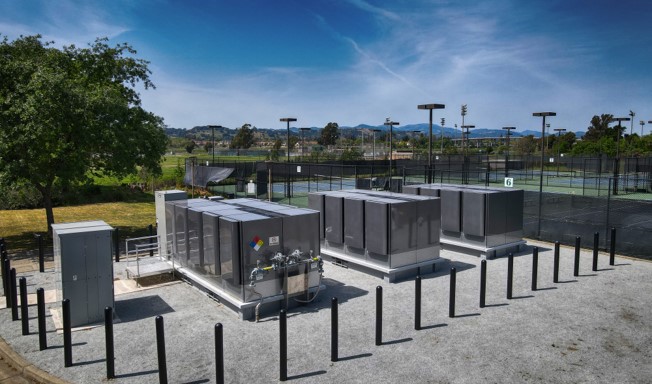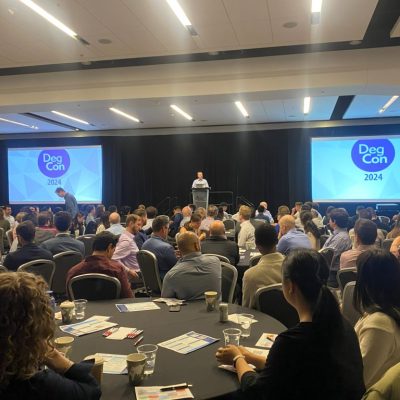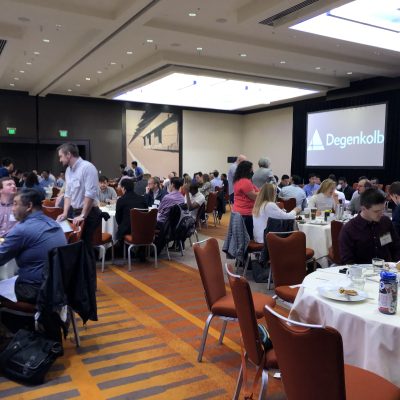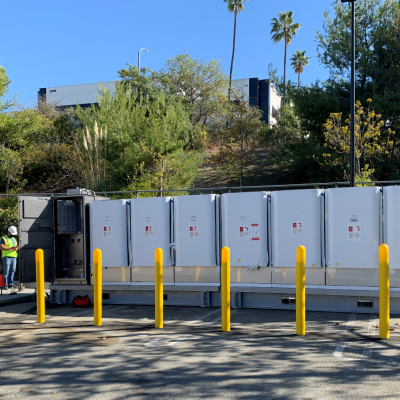For nearly a decade, Degenkolb has been in collaboration with Bloom Energy, an alternative energy organization. Bloom Energy manufactures, markets, and installs its proprietary solid oxide fuel cells called Bloom Energy Servers. The energy servers convert natural gas, biogas, and hydrogen into electricity without combustion to produce low or no CO2 emission electricity on-site for customers. In 2020 the “green energy” organization presented us with a unique opportunity.
Traditionally, Bloom has provided either backup energy or replacement energy sources for large facilities, such as hospitals and data centers, using concrete as a foundation for their energy servers. Matthew Barnard (Principal and Degenkolb’s Orange County Office Director) worked with Bloom on a larger installation at a Kaiser Permanente campus. In 2020, Bloom Energy was motivated to start scaling installations of their energy servers to smaller facilities, for example, Home Depot and Lowes. Bloom started to question if concrete was the most efficient building material for the foundation of their energy servers. In traditional installations on larger sites, Bloom must prepare the ground destination for the energy servers by trenching and compacting soil, pouring concrete, allowing the concrete to cure for 30 days, and then securing the servers into the concrete pad. Although concrete had been a reliable material for larger installations, Bloom became concerned about it being the most efficient, economic, and sustainable material for future use across a variety of projects.

Classic Skid Installation at Napa Valley College
It was then that Bloom began looking for an alternative to concrete that would permit sizable scaling of operations and continued growth of the company. Bloom turned to steel as a potentially viable solution for securing the energy servers from the factory all the way to the site and reached out to Degenkolb Engineers to understand whether this was a viable option to meet Building Code requirements. Degenkolb engineers, Garrett Hagen and Jerry Luong, quickly went to work and began designing a solution.
To address Bloom’s concerns of time, cost, and prospective scalability, the Degenkolb team developed an innovative steel platform base to support the energy servers known as steel skids. The skids designed by Degenkolb allow for multiple energy server units to be bolted together and modularly assembled and anchored onto the steel platform. The steel skids are pre-assembled, then forklifted onto a truck, driven where needed across the country, and then craned onto customer sites. Because each site has unique characteristics, different building codes, and varying load sizes, Degenkolb had to pioneer a streamlined solution that works under many differing conditions. The newly imagined solution is designed so that the energy servers can withstand the stresses of transportation, be crane-lifted, and undergo natural occurrences such as wind and earthquakes, as well as meet all other building code requirements for permanent structures.

First Linear Skid Installation
The new steel skid model also cooperates with Bloom’s business model of leasing energy servers to end users and its initiative toward a sustainable future. During a lease period, Bloom provides maintenance on the energy servers; and once a lease is ended, the energy servers will be returned to Bloom. The steel skids allow for easy removal, leaving no trace, in contrast to being sealed in by concrete. The use of an alternate material such as steel, in contrast to concrete, significantly lowers the carbon footprint of installing the energy servers on-site and improves the overall economy significantly.
Designing a foundation using an alternative material to concrete is unique and must be done with sensitivity to the building code. Degenkolb’s intimate understanding of the intent of the building code allowed the team to be more creative with the design for the skids using steel as opposed to concrete. Because steel is unconventional to use as a foundation, Degenkolb had to show and justify that the skid design continually meets the safety and reliability metrics prescribed by the building code. Degenkolb’s in-depth understanding and integration in building code development permitted the team to innovatively use an alternative material in the solution created for Bloom Energy.
Bloom started its installation of the energy servers using steel skids originally in California. As the new model proved to be effective, the opportunity for Bloom to expand operations became further viable. Bloom decided to expand its market to a variety of other parts of the United States and internationally to Canada, Italy, Saudi Arabia, South Korea, and Taiwan, among others. In light of this expanded growth, Bloom chose to include Degenkolb further and brought the firm on as a trusted advisor and partner to ensure successful installations across the different regions which had varying code regulations. Degenkolb’s expertise in code development and experience with global building materials and resources permitted the team to advise with installations across all of Bloom’s business.

BOD Site with Z-Bracket Anchorage Solution
Degenkolb and Bloom Energy’s partnership on the development of the steel skid design started as a small endeavor but has now grown into Bloom’s de facto approach for installation on a global scale. The small inquiry into optimizing the installations of the energy servers to a variety of clients ultimately led to Bloom’s business model and clientele rapidly expanding across the globe. What Degenkolb produced were cost-effective solutions for the modularized steel skids and custom anchorage that both streamlined Bloom’s field installation and increased accessibility to clean energy for clients. The collaboration with Bloom and serving as a trusted advisor allowed Degenkolb Engineers to fully realize how using our services and expertise in a range of environments enables our client’s visions to succeed.



